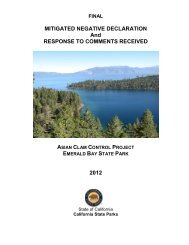Anza Borrego Desert State Park - California State Parks - State of ...
Anza Borrego Desert State Park - California State Parks - State of ...
Anza Borrego Desert State Park - California State Parks - State of ...
Create successful ePaper yourself
Turn your PDF publications into a flip-book with our unique Google optimized e-Paper software.
Final Report – October 2001<br />
How do Visitors Evaluate the Management <strong>of</strong> <strong>Anza</strong><br />
<strong>Borrego</strong> <strong>Desert</strong> <strong>State</strong> <strong>Park</strong>?<br />
An aspect <strong>of</strong> management equally important as identifying and characterizing <strong>Anza</strong><br />
<strong>Borrego</strong>’s visitors is examining visitor support for management actions. Gaining insight<br />
into support for potential management actions is invaluable to managers who must make<br />
decisions that would greatly affect visitor experience in the park. Likewise, management<br />
actions that have little support from visitors may prove to cause future conflict if<br />
implemented.<br />
Measurement <strong>of</strong> Management Support<br />
Respondents were asked to express their support <strong>of</strong> or agreement with various<br />
management actions. Respondents were to rate their support from one, “strongly<br />
oppose” to five, “strongly support” on a series <strong>of</strong> management actions given the<br />
conditions <strong>of</strong> the <strong>Park</strong> on their visit. The management actions were generated from<br />
information supplied by <strong>Anza</strong>-<strong>Borrego</strong> Staff, planning, and policy documents.<br />
Table 35 illustrates the most and least supported management actions on average<br />
(sorted in descending order by the ranking <strong>of</strong> the visitor center respondents). The means<br />
range from “oppose” (2.0) to “strongly support” (4.7). The general trend in the data is that<br />
actions related to the preservation <strong>of</strong> the park’s resources are viewed as more important<br />
than changes in facilities, or development targeting recreational use, visitor concerns or<br />
local interests. That the resources should be protected gained (on average) the most<br />
support in four <strong>of</strong> the six sample sites. This item was among the top three in the<br />
remaining two sites as well. On average, visitors “support” the current management <strong>of</strong><br />
camping and traffic. The least supported management actions are related to providing<br />
more camping or <strong>of</strong>f-road use and <strong>of</strong>fering more emphasis to locals on decision making.<br />
Differences in mean and median indicate a skewed distribution in the data. An example<br />
<strong>of</strong> this can be seen in the Visitor Center respondents’ assessment <strong>of</strong> horseback, <strong>of</strong>f-road<br />
and mountain bike management. While the medians are five, indicating that at least half<br />
<strong>of</strong> the respondents strongly support the current management, the means are closer to<br />
neutral. This indicates that a sizable minority opposes the action and strongly opposes<br />
the current management <strong>of</strong> these recreation types. In most other cases, the assessment<br />
<strong>of</strong> management actions is quite constant across actions and sites. There is little<br />
seasonal difference in the respondents’ reactions to these questions (Table 36).<br />
39
















